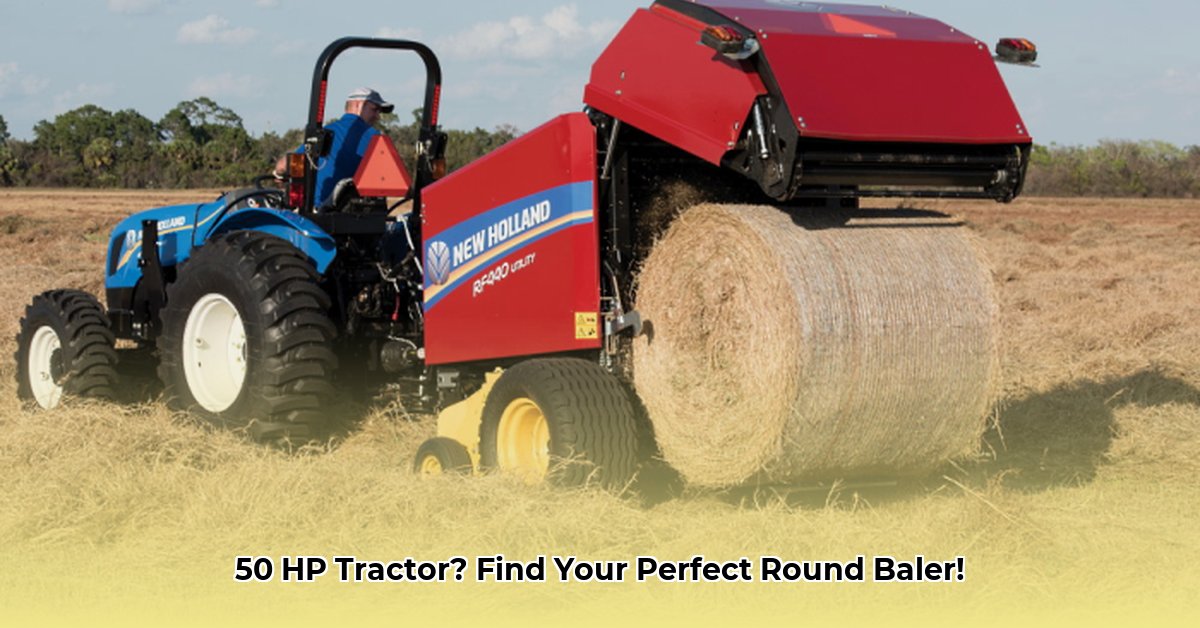
Choosing the right round baler for your 50 horsepower tractor is crucial for efficient and productive hay harvesting. This comprehensive guide will walk you through the selection process, covering key features, maintenance, safety, and budget considerations. By the end, you'll be equipped to make an informed decision that maximizes your yield and minimizes potential problems. For smaller operations, consider a smaller tractor.
Understanding Your Round Baler Options
Two main types of round balers dominate the market: fixed-chamber and variable-chamber. Understanding their differences is key to selecting the right model for your operation.
Fixed-Chamber Balers: These produce consistently sized bales, simplifying storage and handling. This uniformity also contributes to maintaining hay quality through consistent density. Ideal for prioritizing predictable bale size and easy stacking.
Variable-Chamber Balers: These offer greater adaptability, adjusting bale size based on hay density. Denser hay results in smaller, denser bales, saving space; sparser hay leads to larger bales, reducing handling. Excellent for fluctuating hay conditions but may require slightly higher horsepower for denser bales.
Which type is best for you? Consider your typical hay yield consistency, storage methods, and prioritization of consistent bale size versus adaptability.
Key Features to Consider for Your 50 HP Tractor
Several key specifications are crucial when choosing a round baler compatible with your 50 HP tractor. Don't underestimate the importance of these factors in ensuring smooth operation and optimal performance.
Bale Size: For a 50 hp tractor, aim for smaller to medium-sized bales (3ft x 4ft to 4ft x 5ft). Larger bales may overload your tractor, increasing the risk of breakdowns and clogging.
Pickup Width: While a wider pickup (6-7 feet) increases coverage speed, it also places greater stress on your tractor. Balance increased efficiency against your tractor's capacity to avoid overworking it.
Power Take-Off (PTO) Horsepower: Ensure your tractor's PTO horsepower comfortably exceeds the baler's requirement. Leaving a margin helps prevent overheating and breakdowns. Don't push your tractor to its limit.
Knotter Type: Choose between twine and net wrap knotters. Twine is more affordable but net wrap offers faster baling, better bale integrity, and tidier bales. Weigh the cost savings against the benefits of improved bale quality.
Is a wider pickup always better? This rhetorical question highlights the trade-off between speed and tractor strain. A fact to consider: wider pickups significantly reduce the number of passes across a field, potentially saving a significant portion of time overall depending on the size of the field.
Keeping Your Round Baler in Top Condition: A Maintenance Guide
Regular maintenance is crucial for baler longevity and trouble-free operation. Neglecting maintenance can lead to costly repairs and downtime, and even pose safety hazards. Here’s a straightforward maintenance plan:
Lubrication: Follow the manufacturer's instructions for regular lubrication of all moving parts. This prevents wear and tear.
Belt Inspection: Regularly inspect belts for wear, fraying, or stretching. Replace damaged belts promptly to prevent breakdowns.
Knife Sharpening: Sharp knives ensure clean cuts, improving bale quality and preventing blockages. Dull knives can damage both the hay and the equipment.
Troubleshooting: Familiarize yourself with common problems and their solutions (found in your owner's manual). Early problem detection reduces downtime and repair costs.
Safety First: Essential Precautions When Operating a Round Baler
Operating a round baler presents inherent risks. Prioritize safety at all times by following these guidelines:
Protective Gear: Always wear gloves, eye protection, and sturdy, closed-toe footwear. This is not optional.
Hands Off: Never reach into the baler while it's running to prevent serious injury.
Situational Awareness: Constantly monitor your surroundings for bystanders and unexpected obstacles.
Pre-Operation Check: Inspect the baler thoroughly before each use to identify any loose parts, damage, or potential hazards.
Budgeting for Your Round Baler: A Cost Overview
The cost of a new round baler suitable for a 50 hp tractor ranges from roughly $8,000 to $25,000 or more. Used balers offer cost savings, typically ranging from $3,000 to $15,000. Thoroughly inspect any used baler before purchase to ensure its condition.
Is buying used always the most economical choice? While it might seem so, the long-term costs of potential repairs and breakdowns on a used machine may offset the initial savings. Always weigh the initial investment against the potential for future repairs.
Comparing Models: A Sample Comparison Chart
The following table displays sample models. This is not exhaustive; research multiple models before purchasing.
| Feature | Model X | Model Y | Model Z |
|---|---|---|---|
| Bale Size (ft) | 4x5 | 3x4 | 4.5x5.5 |
| Pickup Width (ft) | 6 | 7 | 6.5 |
| PTO HP Required | 40 | 35 | 45 |
| Knotter Type | Twine | Net Wrap | Net Wrap |
| Approx. Price | $10,000 | $9,000 | $16,000 |
Remember to consult with local dealers and experienced farmers for personalized recommendations. The ideal choice depends on your specific circumstances and priorities.